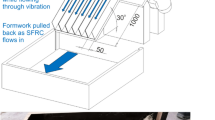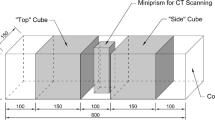Abstract
Successful application with advanced fiber reinforced cement based materials relies on reliable design prescriptions and design-oriented test methodologies for the identification of relevant material properties, together with consistent and effective quality control procedures. The “randomly uniform” dispersion of fibers within a structural element is a crucial issue to be tackled, which, if not achieved, may lead to the activation of unanticipated failure mechanisms, thus lowering the load bearing capacity and jeopardizing the structural performance. It is henceforth evident that non-destructive techniques for fiber dispersion monitoring need to be developed and calibrated, as it has been going on for at least the last lustrum, and their outcomes to be effectively correlated to the mechanical performance of the material. In this paper a non-destructive method based on the magnetic properties of the composite has been applied to monitor the fiber dispersion and orientation in HPFRCC slabs. The results have been correlated to the tensile behaviour, measured according to the newly conceived “Double Edge Wedge Splitting” technique. The work herein presented stands as a step towards the assessment of non-destructive methods for fiber dispersion monitoring and their inclusion into a sound quality control procedure in a design oriented perspective.





Similar content being viewed by others
References
Brandt AM (1985) On the optimal direction of short metal fibres in brittle matrix composites. J Mater Sci 20:3841–3850
Brandt AM (1986) Influence of the fibre orientation on the energy absorption at fracture of SFRC specimens. In: Brandt AM, Marshall IH (eds) Brittle matrix composites 1. Elsevier, London, pp 403–420
Brandt AM (1987) Influence of the fibre orientation on the mechanical properties of fibre reinforced cement (FRC) specimens. In: Proceedings of the international congress RILEM, vol 2, pp 651–658
Martinie L, Roussel N (2010) Fiber reinforced cementitious materials: from intrinsic isotropic behaviour to fiber alignment. In: Khayat KH, Feys D (eds) Design, production and placement of self-consolidating concrete, proceedings of the 6th international RILEM symposium on SCC and the 4th North American conference on the design and use of SCC, SCC 2010, Montreal, Canada, 26–29 September 2010. Springer, pp 407–416
Ferrara L, Tregger N, Shah SP (2010) Flow-induced fiber orientation in SCSFRC: monitoring and prediction. In: Khayat KH, Feys D (eds) Design, production and placement of self-consolidating concrete, proceedings of the 6th international RILEM symposium on SCC and the 4th North American conference on the design and use of SCC, SCC 2010, Montreal, Canada, 26–29 September 2010. Springer, pp 417–428
Stahli P, Custer R, van Mier JGM (2008) On flow properties, fibre distribution, fibre orientation and flexural behaviour of FRC. Mater Struct 41(1):189–196
Ferrara L, Ozyurt N, di Prisco M (2011) High mechanical performance of fiber reinforced cementitious composites: the role of “casting-flow” induced fiber orientation. Mater Struct 44(1):149–168
Model Code 2010, 1st complete draft, March 2010, 2 vol
Ozyurt N, Mason TO, Shah SP (2006) Non destructive monitoring of fiber orientation using AC-IS: an industrial scale application. Cem Concr Res 36:1653–1660
Ferrara L, Faifer M, Toscani S. A magnetic method for non destructive monitoring of fiber dispersion and orientation in steel fiber reinforced cementitious composites—part 1: method calibration. Mater Struct. doi:10.1617/s11527-011-9793-y
di Prisco M, Lamperti MGL, Lapolla S (2010) On Double Edge Wedge Splitting test: preliminary results. In: Oh BH et al (eds) Proceedings FraMCoS 7, Jiejiu, South Korea, 23–28 May 2010, pp 1533–1540
Ferrara L, di Prisco M, Lamperti MGL (2010) Identification of the stress–crack opening behavior of HPFRCC: the role of flow-induced fiber orientation. In: Oh BH et al (eds) Proceedings FraMCoS 7, Jiejiu, South Korea, 23–28 May 2010, pp 1541–1550
Ferrara L, di Prisco M (2011) The role of fiber orientation on strain gardening/softening FRCCs: continuum damage modelling. In: Accepted for presentation to RIO-SHCC2 RILEM international conference, Rio de Janeiro, Brasil, 12–14 December 2011
Soroushian P, Lee CD (1990) Distribution and orientation of fibers in steel fiber reinforced concrete. ACI Mater J 87(5):433–439
Acknowledgments
The authors wish to acknowledge the help of Mr. Stefano Bufalino in performing experimental measurements and tests and reducing data, in partial fulfilment of the requirements for his BSc in Civil and Environmental Engineering. The first author also acknowledges the support of his home institution through the Young Researchers grant, 2010.
Author information
Authors and Affiliations
Corresponding author
Rights and permissions
About this article
Cite this article
Ferrara, L., Faifer, M., Muhaxheri, M. et al. A magnetic method for non destructive monitoring of fiber dispersion and orientation in steel fiber reinforced cementitious composites. Part 2: Correlation to tensile fracture toughness. Mater Struct 45, 591–598 (2012). https://doi.org/10.1617/s11527-011-9794-x
Received:
Accepted:
Published:
Issue Date:
DOI: https://doi.org/10.1617/s11527-011-9794-x




